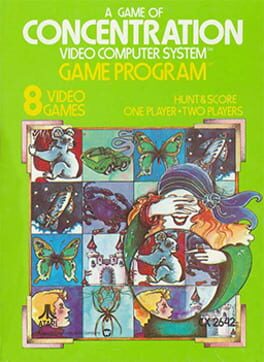

The game is played using a matrix of numbered panels, either 4 x 4 (for 16 panels) or 5 x 6 (for 30 panels). Using the keypad, players enter the number of the panels they wish to reveal. If the images behind the two panels match, the panels are removed and the player scores 1 or 2 points, depending on what difficulty the switch is set to, along with an extra turn. The game has a total of eight variations, four each for each matrix size and four have wild cards. Each matrix can be played by either a single player or by two players taking turns; in single-player games, the player attempts to clear the matrix with as few incorrect matches as possible. Also, players can enable wild cards that will match any image on the board.
Reviews View More
You know, by 1978 I'm sure they were so preoccupied with whether or not they could, that they never really considered whether or not they should. It's your typical memory-based flip-the-cards-and-get-matches type beat, and while I can certainly dunk on this for entirely being something that's more suited for a mini-game in even an NES game, but this do be like literally year 1 atari stuff so I have plenty of slack to cut in the content regard.
That being said though even in the context of its release I think this game is beaten by an actual deck of cards in a lot of ways. For a console that ships with a controller with 4 directions and a button why the hell would you go with needing a proprietary number pad controller to dial in which cards you want to pick instead of like using the joystick as a cursor and the button to select? The single player mode is entirely player-driven when it comes to goals; the manual doesn't even have anything like "try for a score under 10 to be a real Atari Concentration Camper!" or whatever, you just match pictures, and when it's done it's over. There's also a mode that replaces one pair of pictures with 2 wild cards that can be matched with any other card, except for the fact that it doesn't clear both the card the wild card is matching with as well as the card that it's supposed to be matched with, which just leaves you with a dead game at the end as you have two spare cards that cannot match with each other. It makes the wild cards less of an assist feature as they actually just end up being random game-ruining landmines. Very cool.
I get that this game was released in such an early state of gaming that the mere aspect of interacting with your TV to play something normally designed for tabletop play gave this game enough value through novelty, but like there are 2600 launch titles like combat and pong that have way more intuitive and responsive gameplay and control, so even in its time there would be better options to play imo.
That being said though even in the context of its release I think this game is beaten by an actual deck of cards in a lot of ways. For a console that ships with a controller with 4 directions and a button why the hell would you go with needing a proprietary number pad controller to dial in which cards you want to pick instead of like using the joystick as a cursor and the button to select? The single player mode is entirely player-driven when it comes to goals; the manual doesn't even have anything like "try for a score under 10 to be a real Atari Concentration Camper!" or whatever, you just match pictures, and when it's done it's over. There's also a mode that replaces one pair of pictures with 2 wild cards that can be matched with any other card, except for the fact that it doesn't clear both the card the wild card is matching with as well as the card that it's supposed to be matched with, which just leaves you with a dead game at the end as you have two spare cards that cannot match with each other. It makes the wild cards less of an assist feature as they actually just end up being random game-ruining landmines. Very cool.
I get that this game was released in such an early state of gaming that the mere aspect of interacting with your TV to play something normally designed for tabletop play gave this game enough value through novelty, but like there are 2600 launch titles like combat and pong that have way more intuitive and responsive gameplay and control, so even in its time there would be better options to play imo.
